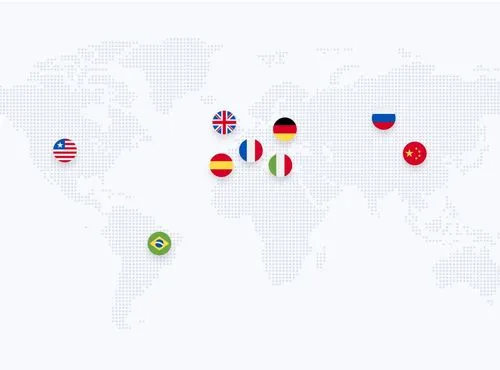Use Cases
September 12, 2025
How to Translate Online Courses Professionally – and Scale International Learning

Why Translate Your Learning Content?
Online learning is growing – globally.
Whether you're a business training your team, a platform provider, or a solo creator, multilingual video content brings powerful benefits:
- Grow into new markets
- Improve accessibility for your current users
- Train international teams with unified content
- Increase understanding and engagement
- Boost your professional image with polished, localized materials
Studies show: People learn better in their native language – especially when dealing with complex or technical content.
The Traditional Way? Complicated and Costly
Translating e-learning videos used to be a major production task:
- Extract the script
- Translate it
- Book voice talent
- Record in a studio
- Re-edit the video
- Sync everything manually
And repeat… for every video, and every language.
It’s expensive, time-consuming, and rigid – especially if your content changes frequently or you manage a large library.
A Better Way: Translate Your Courses with Dubly
Dubly simplifies the process – without compromising on quality.
You upload your video, select a language, define a few settings… and Dubly does the rest:
Here’s how it works:
- Upload your video
- Select your target language and choose your settings (e.g. number of speakers, glossary use)
- Dubly generates the translated voiceover with natural-sounding AI voices
- Automatic lip sync is applied – for a truly polished result
- Download your video – or edit the translation as needed
You stay in full control. Edit translations, apply terminology preferences, even submit videos for native speaker review if required.
Which Languages Make Sense for Your Course?
Choosing the right languages is key. Ask yourself:
- Where is your target audience located?
- Which new markets are you planning to enter?
- Do you already have international teams or users you want to support?
Common e-learning languages include:
- English
- Spanish
- German
- French
- Portuguese
- Polish
- Arabic
- Turkish
Dubly currently supports 30+ languages, with more being added regularly.
Things to Prepare for a Smooth Translation Process
To get the best results, we recommend:
✅ Clear audio and speaker separation
✅ Define your key terminology – use a glossary
✅ Indicate if multiple speakers are involved
✅ Avoid overlapping voices or heavy background music
✅ Use Native Speaker Review for high-stakes or regulated content
The good news: With Dubly, you can edit translations directly – so nothing is ever “locked in.”

Is the Quality Really That Good?
Absolutely – and here’s why:
Dubly is purpose-built for professional video translation. Unlike general AI platforms, we focus specifically on voice quality, timing accuracy, and realistic delivery.
You get:
- 🎙 Natural, expressive voices – not robotic text-to-speech
- 🧠 Custom glossaries to ensure accurate and brand-consistent translations
- 👄 Automatic Lip Sync – so the video looks right, not just sounds right
- 🔁 Editable translations – fully under your control
- 🔐 Full GDPR compliance and EU-grade data protection – no uncontrolled processing on non-EU servers
FAQ: Translating Online Courses Professionally and Scaling International Learning
Why is it worth translating online courses professionally?
Professional translations expand reach, improve completion rates, ensure consistent learning for global teams, and strengthen brand reputation.
What challenges come with frequently updated course content?
Frequent changes, multiple languages, and different speakers create complexity. Without glossaries and flexible workflows, delays and inconsistencies occur.
How does Dubly’s translation process work?
Upload the video, select target languages, define glossary and speakers, generate translation with lip sync, optionally review by native speakers, then download and publish.
What should be prepared before course translation?
Ensure clear audio quality, separate speakers, prepare a glossary, avoid background music, and plan for native speaker feedback on key content.
What sets Dubly apart in quality and security?
Dubly provides natural voices, accurate lip sync, editable translations, glossary integration, and GDPR-compliant processing with EU-based storage.
{{cta}}
{{callout}}
Conclusion: Learning Has No Language Barriers – If You Do It Right
If you're ready to take your knowledge global, you need more than translation.
You need a system that works at scale – with quality you can trust, and support when you need it.
Dubly helps you bring your course to life in every language – naturally, efficiently, and professionally.
Does the Dubly.AI free trial include the Lipsync feature?
Yes. We believe you need to experience the full technology to understand its value. The free trial includes Generative Lipsync and Voice Cloning, not just simple audio translation.
Is there a difference between a standard "Video translater" and Dubly.AI?
Yes. A standard "Video translater" often only translates text or audio. Dubly.AI is a comprehensive AI solution that adapts the visuals (mouth movements) to the audio, creating a seamless experience.
Can I use Dubly.AI for long-form content?
Yes. While many free tools limit you to 60 seconds, Dubly’s engine is built for scale – from TikTok Shorts to hour-long corporate training modules.
Can I use translate video free tools to internationalize my content?
Yes, absolutely. Using free tools is a great starting point to test new markets without a budget. However, keep in mind that methods like subtitles or basic video translator apps usually only transfer information, not emotion. To truly internationalize your brand's personality and retain viewers, you will eventually need lipsync technology to ensure the audience feels connected to you, not just the text.
Does a free ai video translator work for all types of videos?
It works well for content where the speaker is not visible, such as screen recordings or faceless tutorials. However, for any video featuring a person speaking on camera, a standard tool often falls short. Because it lacks lipsync, the visual mismatch distracts the viewer. For content meant to build trust or emotion, you need a solution that adapts both the voice and the visuals.
Is there a free version of Dubly.AI?
You can translate your first video for free so you can validate the quality with your own files. We believe in letting you prove the value first.
Does this work for any language?
Our AI supports over 30 languages, covering the majority of global markets (English, Spanish, German, French, Japanese, Mandarin, etc.). The Lip Sync works universally across these languages.
How accurate is the translation?
AI translation is very good (95%+), but for critical content, context matters. That is why we offer Native Speaker Control (NSC) as an add-on, where humans review the AI's work. This combines the speed of software with the precision of a native speaker.
Can I automate this process?
Yes. For agencies, media houses, or companies with high volume, we offer an API. This allows you to integrate video translation directly into your content management workflow, removing manual upload steps entirely.
Über den Autor

Newest articles

Use Cases
How to Translate Video Free: 3 Ways to multiply your reach
Looking for an AI video translator? We answer how to translate video free using 3 methods: Subtitles, Basic TTS, and Professional Lipsync.

Simon Pieren
December 8, 2025

Use Cases
Translate Video Free: A Guide to AI Translation, Lip Sync & Voice Cloning
Looking to "translate video free"? Learn the technical differences between standard dubbing and generative AI Lip Sync, and how to test professional quality risk-free.

Simon Pieren
November 28, 2025

Use Cases
How AI Video Translation Connects Global Teams
How AI video translation breaks down language barriers in enterprises - secure, empathetic, and scalable.

Simon Pieren
November 24, 2025
